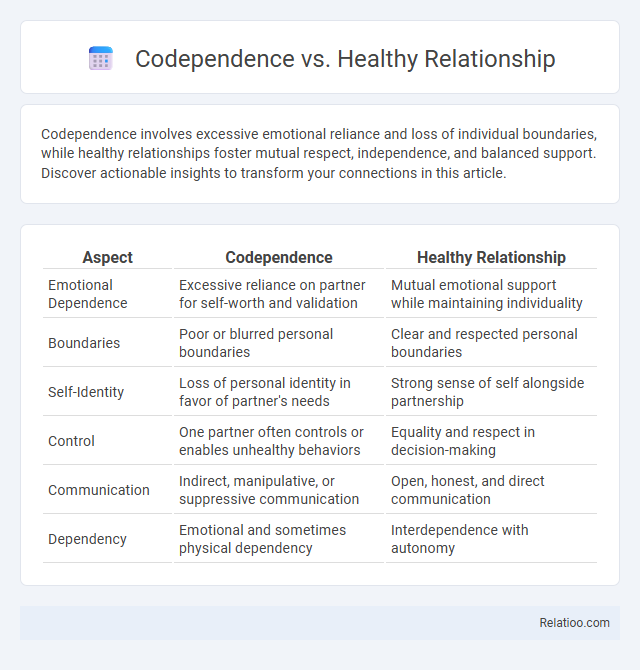Codependence involves excessive emotional reliance and loss of individual boundaries, while healthy relationships foster mutual respect, independence, and balanced support. Discover actionable insights to transform your connections in this article.
Table of Comparison
| Aspect | Codependence | Healthy Relationship |
|---|---|---|
| Emotional Dependence | Excessive reliance on partner for self-worth and validation | Mutual emotional support while maintaining individuality |
| Boundaries | Poor or blurred personal boundaries | Clear and respected personal boundaries |
| Self-Identity | Loss of personal identity in favor of partner's needs | Strong sense of self alongside partnership |
| Control | One partner often controls or enables unhealthy behaviors | Equality and respect in decision-making |
| Communication | Indirect, manipulative, or suppressive communication | Open, honest, and direct communication |
| Dependency | Emotional and sometimes physical dependency | Interdependence with autonomy |
Understanding Codependence: Key Characteristics
Codependence is characterized by excessive emotional reliance on a partner, often leading to a loss of personal boundaries and self-identity. Healthy relationships maintain mutual respect, balanced support, and individual autonomy while fostering interdependence. Recognizing codependence involves identifying patterns such as people-pleasing, difficulty setting boundaries, and an overwhelming need for approval.
Defining a Healthy Relationship
A healthy relationship involves mutual respect, clear boundaries, and open communication, fostering individual growth while supporting each other emotionally. You can recognize it by balanced dependency, where both partners maintain their independence and contribute equally to the relationship's well-being. This contrasts sharply with codependence, which features excessive reliance on one partner for emotional support and identity.
Emotional Boundaries: Codependence vs Healthy Dynamics
In codependence, emotional boundaries are often blurred, leading individuals to prioritize others' needs at the expense of their own well-being, fostering enabling behaviors and emotional exhaustion. Healthy relationships maintain clear emotional boundaries, allowing partners to support each other while preserving individual autonomy and self-care practices. Establishing and respecting emotional boundaries enhances mutual respect, reduces resentment, and promotes balanced interdependence rather than unhealthy reliance.
Communication Styles in Each Relationship Type
In codependent relationships, communication often involves excessive reassurance-seeking and a lack of personal boundaries, leading to imbalance and emotional enmeshment. Healthy relationships feature open, honest dialogue where both partners express needs clearly and listen actively, fostering mutual respect and autonomy. Your ability to recognize these communication styles can help you establish and maintain functional, supportive connections.
Dependency vs Interdependence
Codependence involves excessive emotional or psychological reliance on a partner, often leading to unhealthy dependency where one's identity and well-being hinge on the other. Healthy relationships are characterized by interdependence, where both individuals maintain their autonomy while mutually supporting each other's growth and needs. Interdependence fosters balanced partnership, promoting emotional resilience and personal boundaries, contrasting starkly with the enmeshment typical of codependent dynamics.
Signs and Symptoms of Codependency
Signs and symptoms of codependency include an excessive need to please others, difficulty setting boundaries, and a sense of low self-worth tied to others' approval. In contrast, a healthy relationship features mutual respect, emotional support, and clear boundaries that nurture individual autonomy. Recognizing these patterns helps you differentiate codependence from genuine emotional connection, promoting healthier interpersonal dynamics.
Mutual Respect in Healthy Relationships
Mutual respect in healthy relationships fosters open communication, emotional support, and balanced boundaries, contrasting sharply with codependence where one partner's needs dominate and personal boundaries often erode. Codependent dynamics involve excessive reliance on approval and validation from the other, leading to enabling behaviors and diminished self-worth. Prioritizing respect ensures both partners maintain individuality while nurturing a connection based on equality and trust.
Impact on Personal Growth and Self-Esteem
Codependence often stifles personal growth by fostering dependency and eroding self-esteem, while healthy relationships nurture individuality and empower You to build confidence and autonomy. In healthy dynamics, mutual respect and support create a foundation where self-esteem flourishes, enabling both partners to pursue personal goals without fear of judgment or abandonment. Conversely, codependent relationships trap individuals in patterns of approval-seeking and self-doubt, significantly limiting their ability to develop a strong, independent sense of self.
Breaking the Cycle: Steps Toward Healthy Connections
Breaking the cycle of codependence involves recognizing patterns of excessive emotional reliance and setting clear, healthy boundaries to foster mutual respect and individuality. Developing self-awareness and practicing assertive communication enable individuals to build balanced relationships centered on trust and emotional independence. Consistent efforts toward personal growth and seeking support through therapy or support groups enhance resilience and promote sustainable, healthy connections.
Seeking Help: Therapy and Support Resources
Seeking help in codependence often involves therapy modalities like cognitive-behavioral therapy (CBT) or dialectical behavior therapy (DBT) to develop healthy boundaries and self-esteem. In healthy relationships, counseling focuses on communication skills and mutual respect, emphasizing personal growth without dependency. Support resources such as support groups (e.g., Co-Dependents Anonymous) provide community and strategies for overcoming codependent patterns and fostering emotional independence.

Infographic: Codependence vs Healthy Relationship
 relatioo.com
relatioo.com